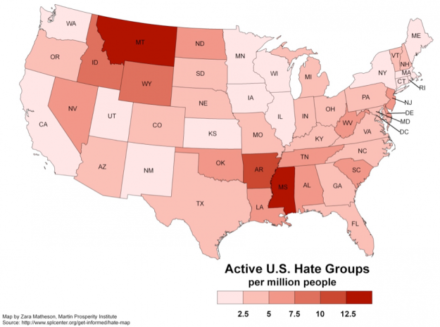Source of article The Jury Room - Keene Trial Consulting.
 We try to keep up with how jurors in various locales vary in attitudes and beliefs. Sometimes that leads us to unlikely places such as a professional publication titled the Annals of the American Association of Geographers. Today’s article is written by a group of geographers and focuses on how hate groups vary geographically with heavier concentrations in some areas of the US than others. The catch is that if you expect most of the heavier concentrations to be in the deep South—the times they are a’changin. While concentrations are much heavier in the eastern half of the US, there are hate groups organized in every state (even in Hawaii). For a current look at where organized hate groups are located in the US, see the Southern Poverty Law Center’s hate map.
We try to keep up with how jurors in various locales vary in attitudes and beliefs. Sometimes that leads us to unlikely places such as a professional publication titled the Annals of the American Association of Geographers. Today’s article is written by a group of geographers and focuses on how hate groups vary geographically with heavier concentrations in some areas of the US than others. The catch is that if you expect most of the heavier concentrations to be in the deep South—the times they are a’changin. While concentrations are much heavier in the eastern half of the US, there are hate groups organized in every state (even in Hawaii). For a current look at where organized hate groups are located in the US, see the Southern Poverty Law Center’s hate map.
The geographers whose article we are featuring today were curious about where hate was strongest within the US. Prior research had always been done on a national level and thus, regional differences were lost. The researchers mapped patterns of active hate groups in every US county in the year 2014 (as identified by the Southern Poverty Law Center). In addition, they analyzed potential socioeconomic and ideological drivers for the hate groups.
The results of the patterns these researchers found are grim and consistent with many stereotypes yet (as in real life) more complicated and nuanced than stereotypes would have us believe.
In all US regions, less education, less population change, and less ethnic diversity was correlated with a higher number of hate groups.
In addition, higher poverty rates, and higher levels of conservative political affiliation was correlated with a higher number of hate groups.
Whether religious belief had a positive or negative relative effect on the number of hate groups varied by geographical region. For example, on the West Coast, more religious people means fewer hate groups. However, in the central US and much of the East Coast more religious people means more hate groups.
The researchers believe that organized hate (as in “hate groups”) is meant to protect a place from perceived threats “outsiders” pose to identity and socioeconomic security of residents. The senior author of the study, Richard Medina, goes further.
“There is a lot of uncertainty in the country today, and a lot of change. For those involved in hate group activities, they see their actions as a way to secure the future of their people. Unfortunately, that fear turns to hate, and in the worst case, violence. Hate is a geographic problem. The ways people hate are based on the cultures, histories, ethnicities and many other factors dependent on place and place perception.”
In other words, reasons for hate in the South are different from what they may be in the “Rust Belt” of the Midwest. As we have often said, attitudes, beliefs and experiences are passed down the generations and are much more important when it comes to selecting jurors than are demographic data points alone.
From a litigation advocacy perspective, this is important information to gather. You want to know what biases come in with your jury pool and tell your case story so that it doesn’t set off whatever “hot buttons” are in existence in your venire.
Visit the Southern Law Poverty Center’s hate map and see how prevalent organized hate groups are in your trial venire. Which hate groups exist and who are their targets of hate? How does that relate to your case and clients? Are any of the parties (or you yourself) the target of organized hate in the trial venire?
Know that when there are organized hate groups in a particular area, there are going to be socioeconomic and political differences (and perhaps even religious affiliation differences). If you are in a venue where extensive voir dire is not allowed, consider who will fit best for your case—is it the person who matches the profile of the venue based on studies like the one we present today—or is it someone who doesn’t fit that profile? As an aside, this article and the “hate map” could be useful tools for a change of venue study.
And these geographers are not the only ones finding this sort of grim reality in today’s America. Tom Jacobs over at PSMag, recently wrote about two other articles (authored by political scientists) exposing the racism, sexism and status fears that drove Republican voters in the 2016 presidential election. Overall, what this growing body of multidisciplinary, yet coalescing, research tells us—loud and clear—is you cannot afford to make assumptions about hate or even “hate-free zones”. Hate lurks pretty much everywhere. We need to watch for it and know it when we see it.
Medina, RM Nicolosi, E. Brewer, S. Linke, AM (2018). Geographies of organized hate in America: A regional analysis. Annals of the American Association of Geographers. https://www.tandfonline.com/doi/abs/10.1080/24694452.2017.1411247?journalCode=raag21

